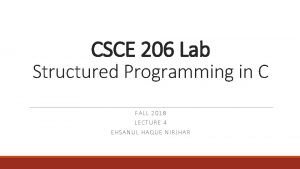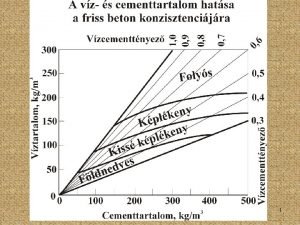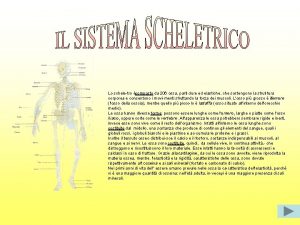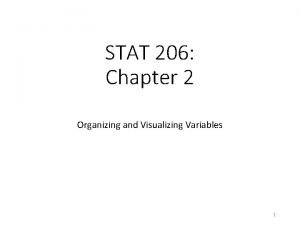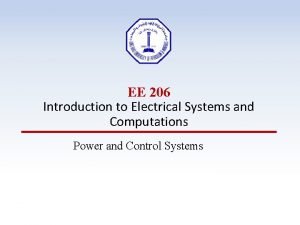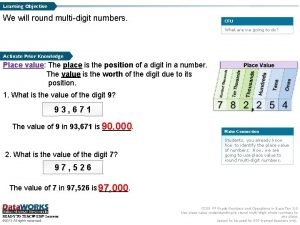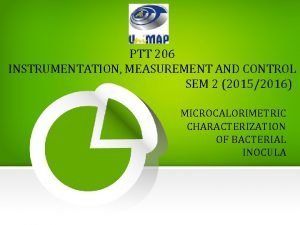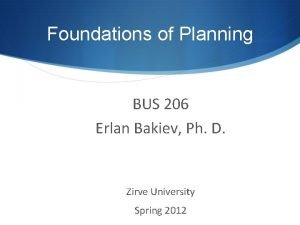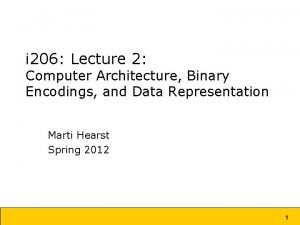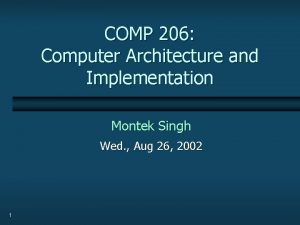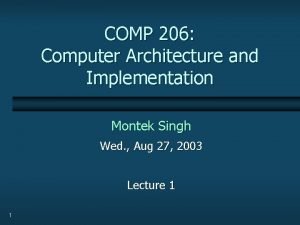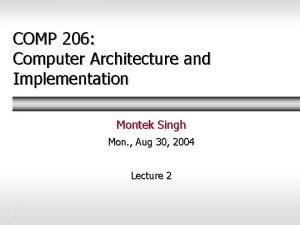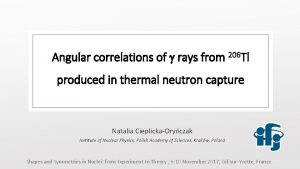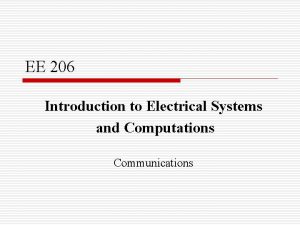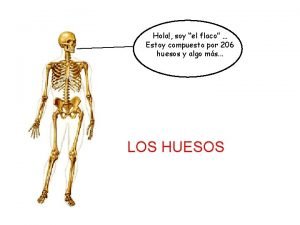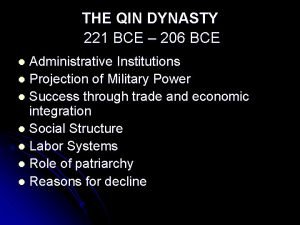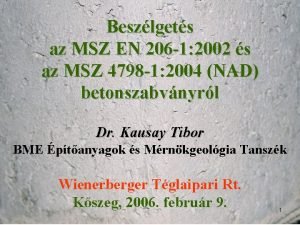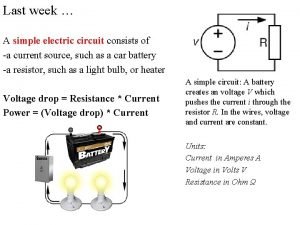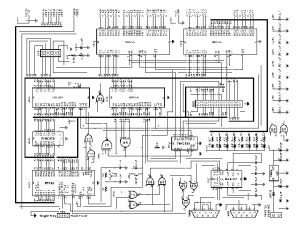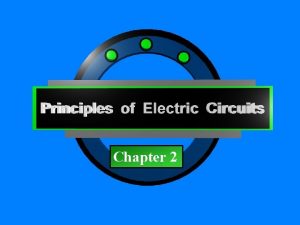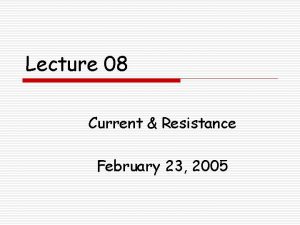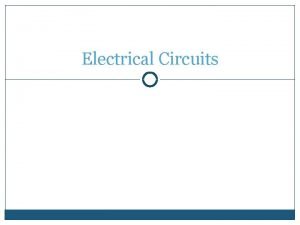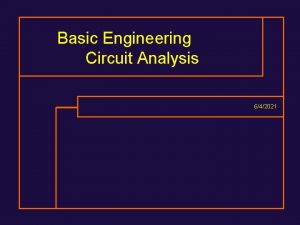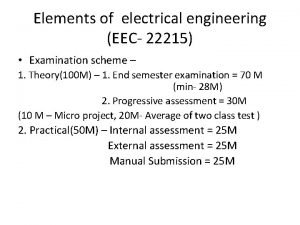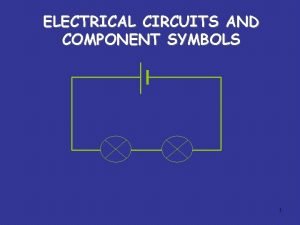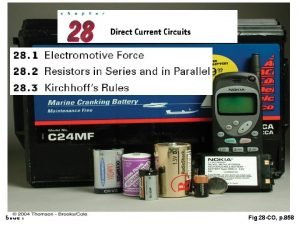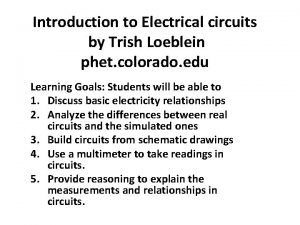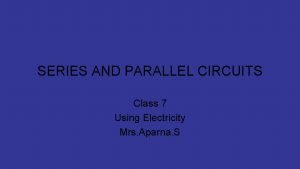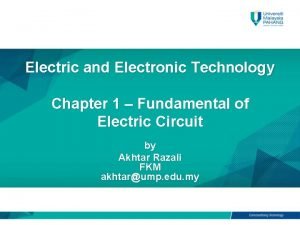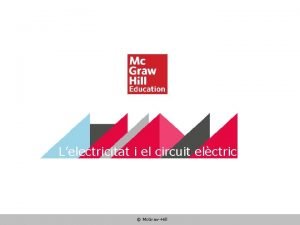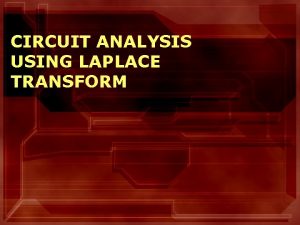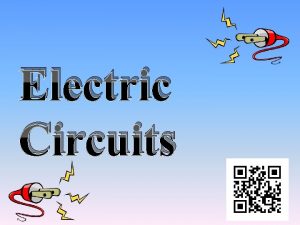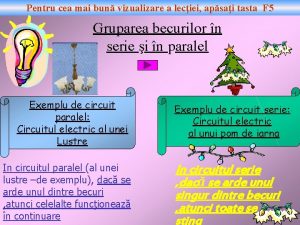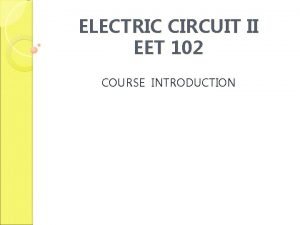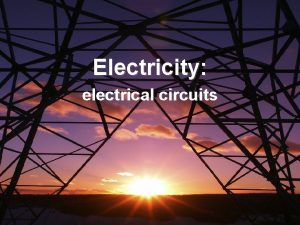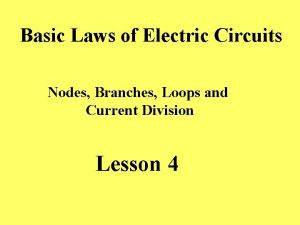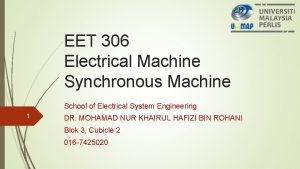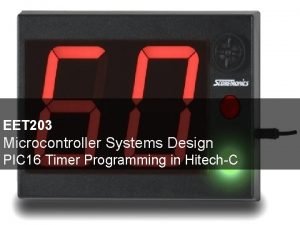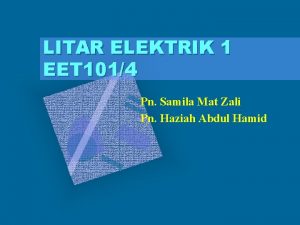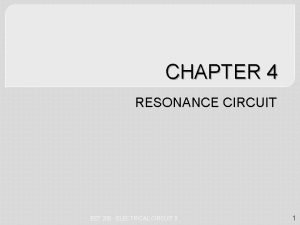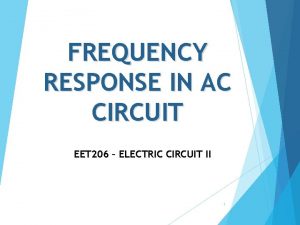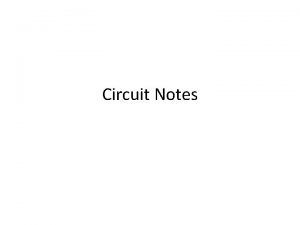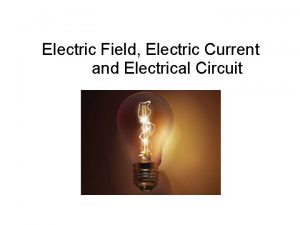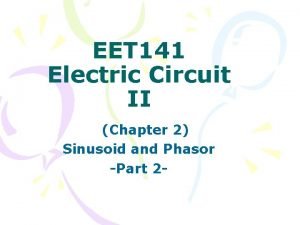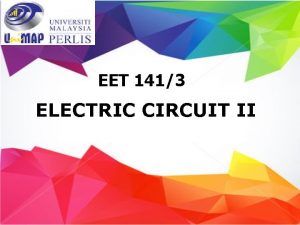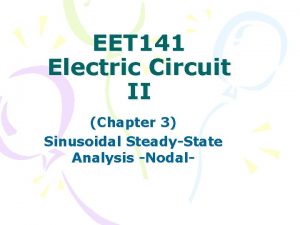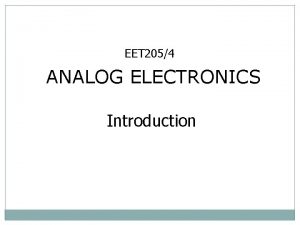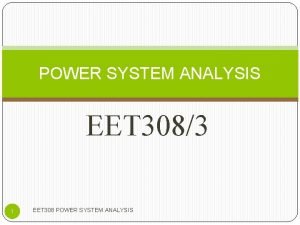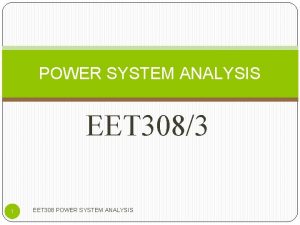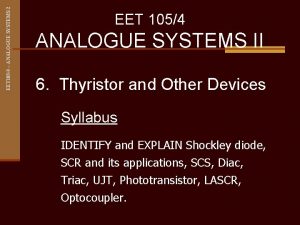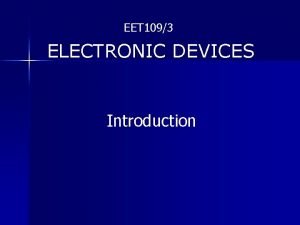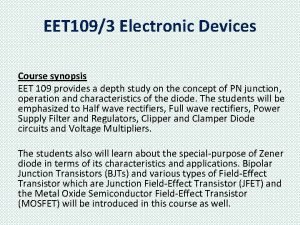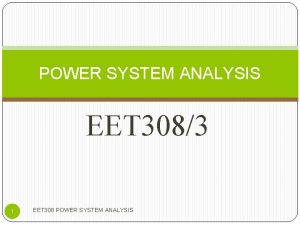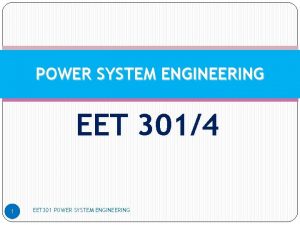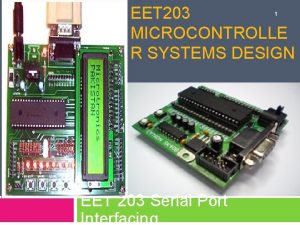EET 206 ELECTRIC CIRCUIT II DR SAMILA MAT





























































- Slides: 61

EET 206 ELECTRIC CIRCUIT II DR SAMILA MAT ZALI DR FIJAY FAUZI 1

COURSE OUTLINE • Chapter 1 : Mutual inductance (Week 1 -2) • Chapter 2 : Laplace transform (Week 3 -5) • Chapter 3 : Frequency response in AC circuit (Week 6 -8) • Chapter 4 : Fourier series (Week 9 -10) • Chapter 5 : Fourier transform (Week 11 -12) • Chapter 6 : Two port network (Week 13 -14) 2

COURSE OUTCOME (CO) CO 1: • Ability to explain and analyse special types of circuit such as mutual inductance and two port networks. CO 2: • Ability to analyse electric circuits using Laplace Transform, Fourier Series and Fourier Transform for the circuit comprising passive elements. CO 3: • Ability to analyse the concepts of frequency response for AC circuits and construct Bode plot for various types of transfer function. 3

COURSE ASSESSMENT 1. COURSEWORK • -Assignment 1 & 2 • -Quiz 10% 30% 2. MIDTERM EXAM 20% 3. FINAL EXAM 50% 4

CHAPTER 1 OUTLINE • INTRODUCTION OF TRANSFORMER • MUTUAL INDUCTANCE • ENERGY IN A COUPLED CIRCUIT • LINEAR TRANSFORMERS • IDEAL TRANSFORMERS 5

INTRODUCTION OF TRANSFORMER An electrical device designed on the basis of the concept of magnetic coupling. Transfer energy from one circuit to another circuit using magnetically coupled coils. Known as key circuit elements in power systems for stepping up or stepping down AC voltages or current; in electronic circuits as impedance matching , and isolating one part of the circuit from another. 6

MUTUAL INDUCTANCE Ability of one inductor to induce a voltage across another inductor when two inductors are in close to each other. The magnetic flux caused by current in one coil links with the other coil. Faraday’s law – the voltage v induced in the coil is proportional to the number of turns N and the time rate of change of the magnetic flux 7

• Flux, is produce by current, i; changes in is caused by a change in i. • Know as self inductance because relates the voltage induced in a coil by a timevarying current in the same coil. 8

Self Inductance • Definition: Inductance that relates the induced voltage in a coil with a time-varying current in the same coil. • The reason why L is called “Self” Inductance is because the Inductance is the result of its own current (current flowing through its own coil).

• Entire flux 1 links coil 1, the voltage induced in coil 1 is: Self inductance of coil 1 • Only 12 links coil 2, so the voltage induced in coil 2 is: Mutual inductance of coil 2 with respect to coil 1 EET 102 ELECTRIC CIRCUIT II • The open circuit mutual voltage across coil 2. • Magnetic flux 1 emanating from coil 1 has two components: 10

• Entire flux 2 links coil 1, the voltage induced in coil 1 is: Self inductance of coil 2 • Only 21 links coil 2, so the voltage induced in coil 2 is: Mutual inductance of coil 1 with respect to coil 2 EET 102 ELECTRIC CIRCUIT II • The open circuit mutual voltage across coil 1. • Magnetic flux 2 emanating from coil 1 has two components: 11

M is refer as mutual inductance between the two coils. • Mutual coupling exists when inductors or coils are in close proximity and circuit are driven by time-varying sources. • Mutual inductance is the ability of one inductor to induce voltage across a neighboring inductor, measured in henrys (H). 12

What do we use magnetically coupling coils for? At least three uses of magnetically coupling coils: 1. For storing energy from circuit 1 (connected to coil 1) to then deliver the energy to circuit 2 using coil 2 such as that in the Flyback circuit. 2. To transfer energy from circuit 1 to circuit 2 using coil 2 such as that in the Forward circuit 3. Isolation between the two circuits (circuit 1 and 2 may have different grounds) Isolation Transformer

Dot convention Mutual inductance M is always positive quantity but mutual voltage M di/dt may be negative or positive. A dot is placed in the circuit at one end of each of the two magnetically coupled coils to indicate the direction of magnetic flux if current enters that dotted terminal of the coil. The dots are used along with the dot convention to determine the polarity of the mutual voltage. 14

Dot convention state as: • If a current enters the dotted terminal of one coil, the reference polarity of mutual voltage in second coil is positive at dotted terminal of second coil. • If a current leaves the dotted terminal of one coil, the reference polarity of mutual voltage in second coil is negative at dotted terminal of second coil. 15 Illustration of the dot convention

Examples of illustrating applying dot convention 16

Dot convention for coils in series; the sign indicates the polarity of the mutual voltage; (a) series-aiding connection, (b) series-opposing connection. 17

Series Adding Connection (with two coils)


• Thus, for Series Adding Connection:

Series Opposing Connection (with two coils)


• Thus, for Series Opposing Connection:

EXAMPLE (Calculate the total inductance)

• For coil 1: • For coil 2: • For coil 3:

TIME DOMAIN ANALYSIS (Example 1) • Applying KVL • Coil 1 • Coil 2 26 Time-domain analysis of a circuit containing coupled coils

FREQ DOMAIN ANALYSIS (Example 2) • Applying KVL • Coil 1 • Coil 2 27 Frequency-domain analysis of a circuit containing coupled coils

Example 3 • Applying KVL for coil 1: 28

• Applying KVL for coil 2: 29

• Substituting I 2 in equation coil 1 30

CHAPTER OUTLINE • INTRODUCTION OF TRANSFORMER • MUTUAL INDUCTANCE • ENERGY IN A COUPLED CIRCUIT • LINEAR TRANSFORMERS • IDEAL TRANSFORMERS 31

ENERGY IN A COUPLED CIRCUIT • Energy stored in inductor is: Power in coil 1: Energy stored in coil 1: 32

• Maintain i 1=I 1 ; increase i 2 from zero to I 2. Power in coil 2: Energy stored in coil 2: 33

• Total energy stored in the coil when i 1 & i 2 reached constant value: • Since M 12 = M 21 = M • Coil current both entered the dotted terminals. 34

• If one current enters one dotted terminal while the other current leaves the other dotted terminal, the mutual voltage is negative. • Generally, energy stored in magnetically coupled circuit is: 35

• Energy stored in the circuit cannot be negative because the circuit is passive. • Coupling coefficient k is a measure of the magnetic coupling between two coils; 0 k 1 36

Example 4 Consider the circuit below. Determine the coupling coefficient. Calculate the energy stored in the coupled inductors at time t = 1 s if v=60 cos(4 t +30°) V. 37

• Coupling coefficient • Indicate that the inductors are tightly coupled. • Obtain the frequency-domain equivalent 38

• Mesh 1: • Mesh 2: 39

• Substituting I 2 in mesh 1 • In time-domain: 40

• Total energy stored: 41

LINEAR TRANSFORMER It is generally a four-terminal device comprising two or more magnetically coupled coils. • Primary coil is connected to voltage source. • Secondary coils is connected to the load. • R 1 and R 2 are included to calculate losses in coil. 42

• To obtain input impedance, Zin; KVL is applying in the two loop as below: • Substituting I 2 in I 1; the input impedance is: • where, 43

Equivalent circuit of Linear Transformer Can be divided into 2 equivalent; • T circuit • circuit. 44

Voltage-current relationship for primary and secondary coils Matrix equation: Matrix inversion: 45

Equivalent T circuit 46

• Mesh analysis is apply in T (or Y) network. • If T circuit and linear circuit are equivalent, then: 47

Equivalent circuit 48

• Nodal analysis is apply in (or ) network. • Equating terms in admittance matrices of above; obtain: 49

Example 5 In the circuit above, calculate the input impedance and current I 1. Take Z 1=60 -j 100Ω, Z 2=30+j 40Ω, and ZL=80+j 60Ω. 50

51

CHAPTER OUTLINE • INTRODUCTION OF TRANSFORMER • MUTUAL INDUCTANCE • ENERGY IN A COUPLED CIRCUIT • LINEAR TRANSFORMERS • IDEAL TRANSFORMERS 52

IDEAL TRANSFORMER • Is a unity-coupled (k=1), (k=1) lossless (R 1=R 2=0) transformer in which the primary and secondary coils have infinite selfinductances (L 1 &L 2 infinity) 53

• From Faraday’s law: • Voltage across primary winding is • Voltage across secondary winding is • Transformer ratio: 54

• Energy supplied to the primary must equal to energy absorbed by secondary since no losses in ideal transformer. • Primary and secondary currents are related to the turns ratio. Thus, 55

• Step-up transformer • If n 1, the voltage is increased from primary to secondary (V 2 V 1). • Step-down transformer • If n 1, the voltage decreased from primary to secondary (V 2 V 1). 56

Typical circuits in ideal transformer 57

• From the transformer turn ratio, the V 1, V 2, I 1 or I 2 can express as: • The complex power in primary winding for ideal is: 58

• Know that: • Since V 2/I 2 = ZL , thus: Also known as reflected impedance 59

Example 6 An ideal transformer is rated at 2400/120 V, 9. 6 k. VA, and has 50 turns on the secondary side. Calculate: (a) the turns ratio, (b) the number of turns on the primary side (c) the current ratings for the primary and secondary windings. 60

61
 A suitable electric pump in an electric circuit is a
A suitable electric pump in an electric circuit is a Units of charge
Units of charge Electric field electric potential
Electric field electric potential Units of a charge
Units of a charge Electric energy formula
Electric energy formula Chapter 21 electric charge and electric field
Chapter 21 electric charge and electric field Electric charges and electric forces lesson outline
Electric charges and electric forces lesson outline Potential energy due to point charge
Potential energy due to point charge Chapter 21 electric charge and electric field
Chapter 21 electric charge and electric field Electric potential energy
Electric potential energy Csce 206 tamu
Csce 206 tamu Arizona fair wages and healthy families act
Arizona fair wages and healthy families act En 206
En 206 Ossa coxarum
Ossa coxarum Stat 206
Stat 206 Ee206
Ee206 Comp 206
Comp 206 Round 787 206 to the nearest ten
Round 787 206 to the nearest ten 206 ptt
206 ptt Plan bus 206
Plan bus 206 206 to binary
206 to binary Comp 206
Comp 206 Comp 206
Comp 206 Common case fast
Common case fast 206 tl
206 tl Psir 206
Psir 206 Ee 206
Ee 206 Qué forma tiene un hueso
Qué forma tiene un hueso 221 bce
221 bce En 206-1
En 206-1 Sn en 206
Sn en 206 Psir 206
Psir 206 Me gustan me encantan (p. 135)
Me gustan me encantan (p. 135) 206-684-0268
206-684-0268 Econ 206
Econ 206 A simple electrical circuit consists of
A simple electrical circuit consists of Electric circuit analogy
Electric circuit analogy Principle of electric circuit
Principle of electric circuit Chapter 23 electric current circuit happenings
Chapter 23 electric current circuit happenings Torch electric circuit
Torch electric circuit Desain instalasi listrik
Desain instalasi listrik Electricity and magnetism
Electricity and magnetism Electric circuit elements
Electric circuit elements Fleming right hand rule
Fleming right hand rule Draw a simple electric circuit and label the parts
Draw a simple electric circuit and label the parts Superposition theoram
Superposition theoram Phet circuit construction kit
Phet circuit construction kit Fusao
Fusao Series circuit class 7
Series circuit class 7 Electric circuit definition
Electric circuit definition Sentit real del corrent electric
Sentit real del corrent electric Electric circuit analysis using laplace transform
Electric circuit analysis using laplace transform Draw and label the parts of basic electrical circuit
Draw and label the parts of basic electrical circuit Deseneaza pe caiet puncte ca in imagine
Deseneaza pe caiet puncte ca in imagine Electric circuit
Electric circuit Electric current drawing
Electric current drawing Nodes branches and loops
Nodes branches and loops Plattegrond emc
Plattegrond emc Eet machine
Eet machine Expanding expression tool
Expanding expression tool Wat eet een koala
Wat eet een koala Eet 203
Eet 203










